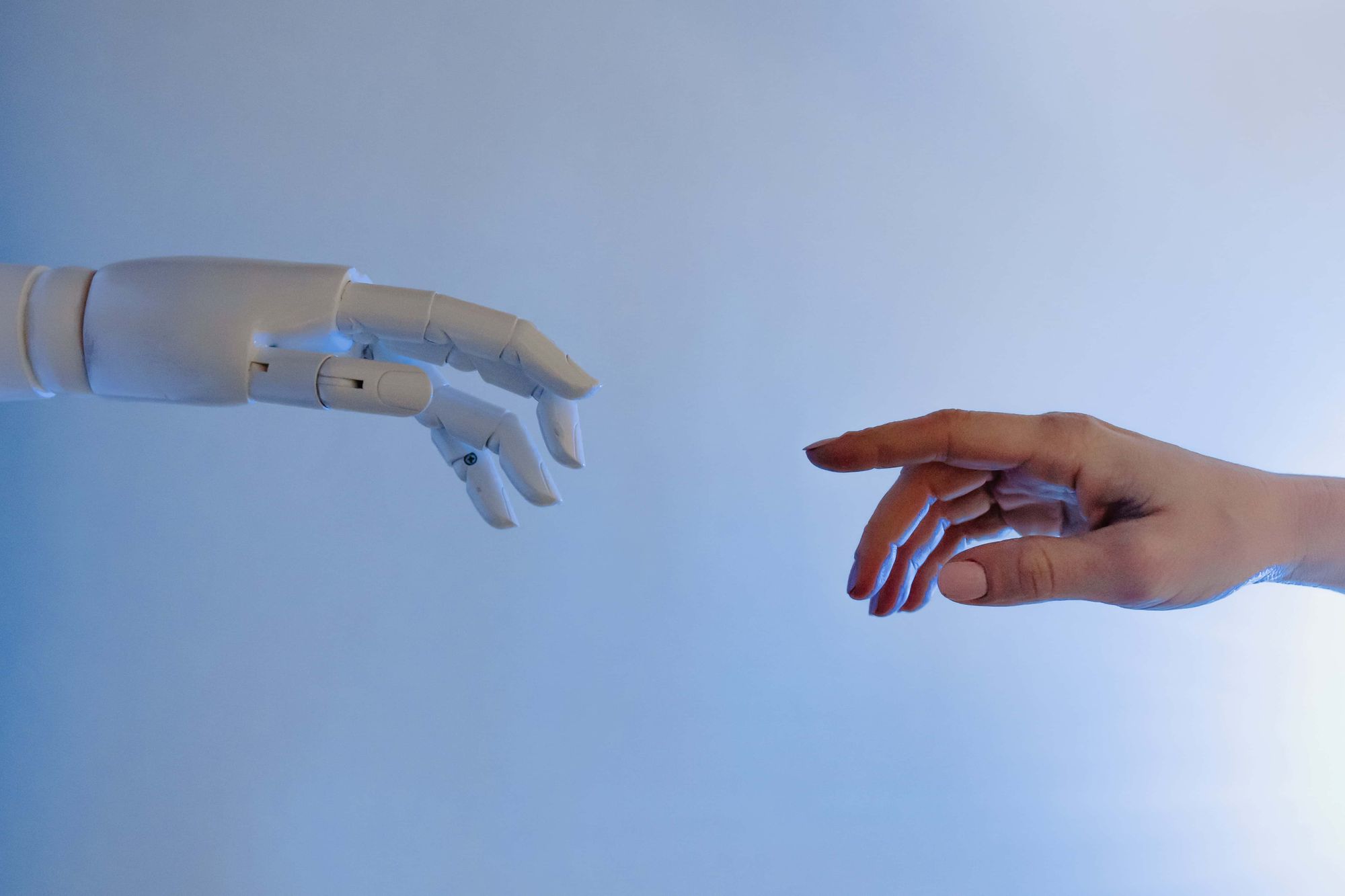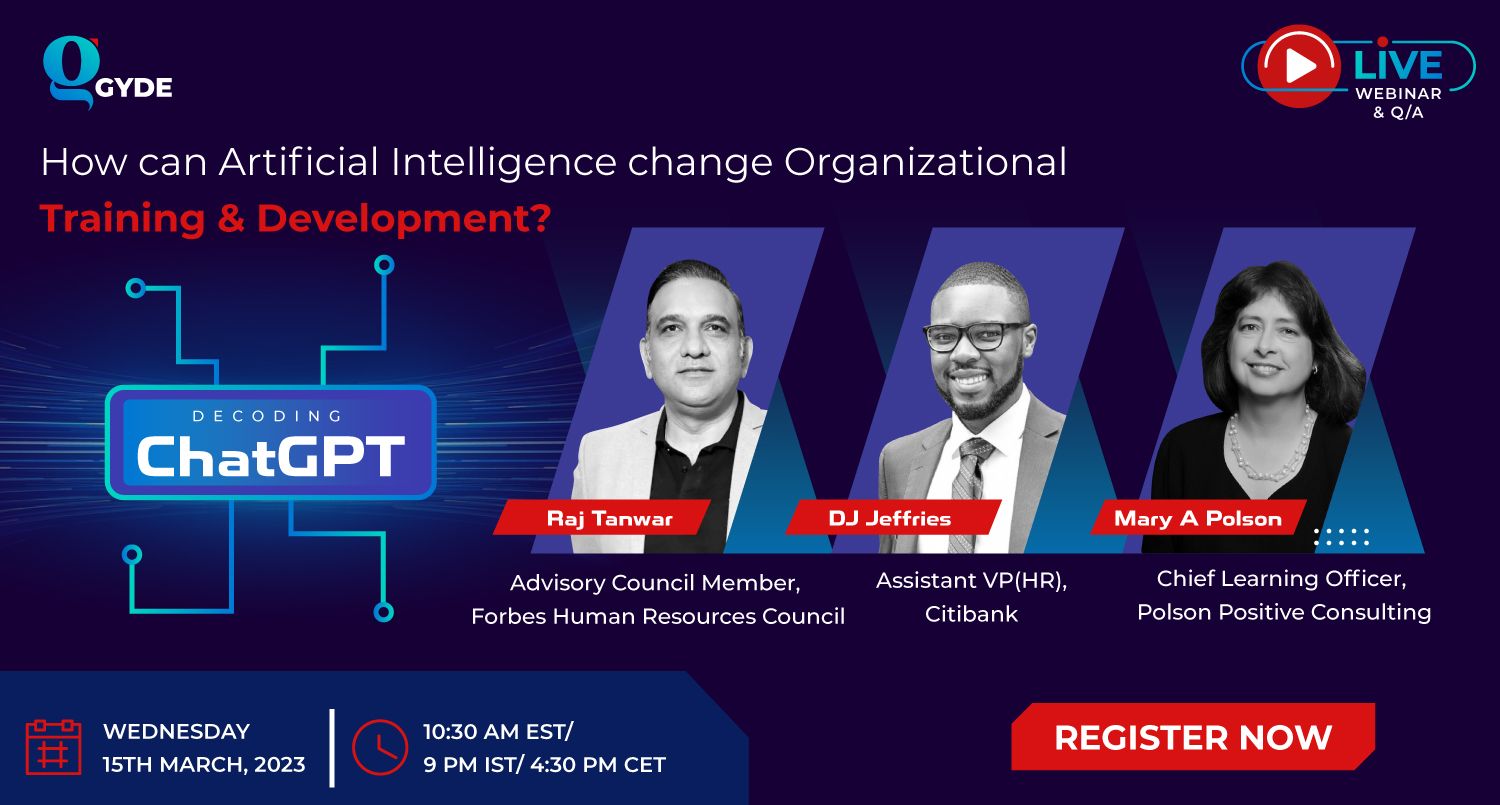Nearly half of all employees - 49%, to be exact - report not having enough time for learning.
L&D leaders recognize that employees should be able to focus on the tasks that matter most while leveraging the power of AI to augment their learning experiences.
AI is rapidly evolving, and one of the exciting new developments is OpenAI's cutting-edge language model, ChatGPT. It can do a lot to transform the corporate training and development landscape.
As we progress in this blog, you'll see how to use ChatGPT for your employees and learn about 15 prompts you can start using immediately.
But first, let's examine how AI advancements can be integrated into L&D programs.
Impact of AI on corporate training and development
Corporate training focused on specific skills or knowledge imparted with the help of overhead projectors, whiteboards, and long hour presentations.
The result, however, was that employees usually had minimal retention and hampered overall employee productivity.
But with Artificial Intelligence in the picture, we see significant advancements impacting corporate training and development.
L&D teams incorporate AI-powered tools that help personalize the learning experience, improve the delivery of instructional content, and provide real-time support to learners.
Let's take a quick look at how AI paves the way for growth and innovation in the learning and development industry.
1. Intelligent Tutoring Systems(ITS):
These AI-powered systems provide personalized feedback and guidance to learners as they work through the training program.
The AI component of these systems can analyze a learner's performance and adapt the instruction to meet their individual needs. Many LMS & LXM, such as Valamis and TalentLMS, have these ITS components.
2. Chatbots & Virtual Assistants:
AI-powered chatbots and virtual assistants provide 24/7 support to learners by answering their questions and guiding them through the material.
These tools are designed to offer quick and convenient support to learners, reducing the need for human involvement. We can see QnA Maker, and OpenAI's GPT-3, as examples.
3. Automated Content Creation:
AI can create educational content such as videos, quizzes, and interactive materials. This technology can save time and resources for educators and trainers, allowing them to focus on other aspects of their work. We can see ChatGPT as an example.
4. Predictive Analytics:
AI-powered predictive analytics can predict learners’ performance, identify employees who need help, and provide personalized interventions to help them improve.
These tools can provide valuable insights into learners' progress and help L&D teams to tailor their support accordingly. Workday Learning, SAP SuccessFactors, and Blackboard Insights are examples of software that offer AI-powered predictive analytics.
5. Adaptive Testing:
AI-powered adaptive testing adjusts the difficulty of questions based on a learner's performance, providing a more accurate assessment of their knowledge and skills.
These tests are designed to adapt in real time, helping learners progress at a pace that suits their needs. Smart Sparrow, Unifed Classroom are some tools that have AI-powered adaptive learning.
6. Gamified Learning:
AI-powered gamified learning experiences use game mechanics and elements to engage learners and make the learning experience more enjoyable.
Gamification can motivate learners and keep them engaged with the material, leading to improved learning outcomes. Classcraft, Kahoot!, and GamEffective are tools that L&D can include in their training programs.

By now, you must have understood the holy grail of creating exceptional training programs is integrating Artificial Intelligence into them.
Let's explore ChatGPT capabilities, and some concrete prompts to help you harness those merits in your training initiatives.
ChatGPT Capabilities
Leveraging ChatGPT can help L&D in various domains and applications. Its functionalities include language translation, text summarization, question-answering, and content creation. But how can L&D teams use it?
Let’s walk you through them quickly -
- Create or repurpose personalized training programs tailored to each employee's needs and learning styles.
- Analyze learning data and provide insights to help L&D professionals optimize training programs, identify knowledge gaps, and measure learning outcomes.
- Provide instant feedback and guidance to learners to help them understand and apply the concepts they are learning effectively.
- Deliver on-demand learning that learners can access anytime, anywhere.
Having learned about ChatGPT's L&D capabilities, here are a few benefits and prompts to help you use ChatGPT at its full potential.
ChatGPT Benefits and Prompts for L&D
1.Personalization -
Imagine a world where you could have a super smart personal learning coach who's always available and has all the answers to your questions. That's precisely what ChatGPT brings to the table for corporate training and development!
L&D managers can customize their training and development experiences with personalized learning according to the preferences and needs of concerned employees.
This approach departs from the traditional one-size-fits-all approach and gives more of a personal touch to the whole learning experience.
Takeaway 1 - The traditional training model is out, and a new, dynamic approach is in.
Here are some of the steal-worthy ChatGPT prompts you can use to personalize your training and development -
- What are the training and development needs for __________? (e.g., your role, department, specific skills, etc.)
- What are the biggest challenges faced in training and development for __________? (e.g., your role, department, specific skills, etc.)
- Provide more details on preferred learning style and pace for __________? (e.g., a specific skill, training, etc.)
- What are the goals and desired outcomes for training and development in __________? (e.g., a specific skill, subject, etc.)
- What resources and materials have been most helpful for training and development for __________? (e.g., a specific skill, subject, etc.)

The trick here is to make your prompts as detailed as possible. You can also use roleplaying for getting more personalized responses.
You can provide all the further details -
- job role or field of work
- training and development goals
- the type of content they prefer
- preferred format of training material (e.g., text, video, audio, etc.)
- preferred frequency of training material (e.g., daily, weekly, monthly, etc.)
2.Efficiency
When it comes to training and development, efficiency is vital. With AI, we can say goodbye to repetitive manual tasks and hello to a more personalized and data-driven approach to training and development.
AI in HR has been reported to reduce administrative tasks by 72% and boost productivity at warp speed. In other words, HR professionals can focus on tasks that require higher-level skills, such as empathy, creativity, and problem-solving (since ChatGPT isn't capable of it).
Takeaway 2 - By incorporating ChatGPT into training and upskilling initiatives, HR and L&D departments can enhance the employee learning experience - improving training efficiency and providing just-in-time support.
Take advantage of these five ChatGPT prompts to add a personal touch to your training programs.
- Please generate a [training module/course outline/program agenda] that covers the following topics: [insert topics here].
- What are the most effective methods for delivering [skill/competency] training to a [team/department]?
- Please recommend [number] resources, such as articles, videos, or books, to help employees [insert the desired outcome here].
- How can we use technology, such as gamification, to make [training program/course/module] more engaging and effective?
- What are the best practices for measuring the impact and effectiveness of [training program/course/module]?

The prompt mentioned in the image gave further details about customer acquisition, some assessment questions, time duration and references for your employees.
These prompts can give even more detailed answers to your queries if you insert the following-
- specific tasks or objectives
- measurable goal or outcome
- time constraint or deadline
- target audience or employee group
- preferred learning style or format
3.Flexibility
Flexibility is critical to a successful learning and development program, from providing self-paced learning opportunities to tailoring training content to meet employees' specific needs.
Artificial Intelligence eliminates the need for scheduled training sessions and allows employees to learn when it's most convenient.
ChatGPT delivers a winning solution for L&D leaders with its on-demand access, conversational interface, and 24/7 availability.
Takeaway 3 - Your employees' ability to apply what they've learned to their day-to-day work will exponentially increase efficiency and productivity.
- What are some flexible learning options that employees prefer for __________?(e.g., CRM, Sales)
- How can we make __________ training and development programs more accessible to employees in __________?(e.g., customer success, business development)
- What steps can we take to accommodate different learning styles and preferences of __________?
- How can we incorporate self-paced learning into our training and development programs for __________?
- What technologies can we use to support flexible and remote learning for __________?
ChatGPT delivers flexibility without any hassle. The prompts provide a roadmap to tailor training programs that meet your needs.
Your efforts in crafting training plans will have a solid base to build upon through your research.
To cut a long story short - L&D leaders can leverage this tool to streamline the creation of training templates, jumpstart their research with a plausible foundation or gain inspiration for their next training project.

What are the Limitations of ChatGPT?
ChatGPT is a great tool, but it's not perfect. Using it lets you figure out what it does well and what it doesn't. You'll still need to put in some extra effort(L&D experience and creativity) to make the most of your training and development opportunities.
So, here are all the limitations you need to know -
- Limited Interaction - ChatGPT may not be equipped to handle unexpected or out-of-scope inputs, limiting the interaction and thus giving a generic output.
- Dependence on training data - ChatGPT can give you these general answers as trained on that data. It is pretty basic, as you can see in the image above. That’s the dependence on training data.
- Updated only till 2021 - ChatGPT can sometimes produce incorrect answers as it has a limited understanding of world events and affairs after 2021. It may occasionally produce harmful instructions or biased content.
- Lack of Human feedback - This limitation can lead to persistent inaccuracies or misunderstandings in its outputs and thus will always need human feedback.
- ‘At the capacity’ problem - Due to many users using ChatGPT simultaneously, the system is jammed most of the time.
Takeaway 4 - AI won’t replace humans or won’t take over jobs, but knowing the capabilities and limitations will surely help you to start or pivot your training initiatives.
Final Thoughts
The future of training and development is like a mystery waiting to be unraveled. But one thing's for sure, the old way of memorizing information won't cut it anymore.
Instead, imagine a world where employees are equipped with the skills to fish out the information they need when they need it to make big wins for their companies.
And with ChatGPT leading the charge, this future is pretty close. ChatGPT is already paving the way for a more flexible and personalized training experience, putting employees in the driver's seat of their learning journey.
FAQs
1. Is ChatGPT free?
Yes(as of now). ChatGPT is in its research phase; it is free of cost for everyone. Open AI has launched ChatGPT Plus, a paid version for $20 per month. The objective is to establish a dependency and subsequently generate revenue.
2. What are examples of artificial intelligence in training and development?
- Virtual Training Assistants: AI-powered chatbots that can answer questions and guide learners in real time.
- Intelligent E-learning Systems: AI algorithms that analyze learners' performance and adjust the learning experience accordingly.
- Personalized Learning Experiences: AI systems that can identify a learner's strengths, weaknesses, and learning styles and provide customized learning paths.
- Automated Evaluation Systems: AI-powered systems that can grade assignments and provide instant feedback to learners.
3. What is ChatGPT, and how does it works?
ChatGPT is a language model developed by OpenAI that uses deep learning algorithms to generate human-like text responses. It has been trained on a massive amount of text data and can generate responses to various questions and prompts. When a user inputs a prompt, ChatGPT processes it and predicts the most likely response based on its training data. The output is then presented to the user as the final response.
4. How could ChatGPT be used in the workplace generally?
ChatGPT can be used in various industries to automate repetitive tasks and provide quick, accurate responses. For example, in customer service, ChatGPT can respond to customer inquiries 24/7, freeing human agents to handle more complex issues. In HR, ChatGPT can assist with HR tasks such as onboarding, benefits information, and policy answers. In marketing, ChatGPT can assist with content creation and market research.
5. What are the alternatives for ChatGPT?
Other advanced language models include GPT-3 by OpenAI, BERT by Google, and XLNet by Google and CMU. These models use similar deep learning algorithms and have been trained on massive amounts of text data to generate human-like text responses. They can be used in similar applications as ChatGPT, but each model has unique strengths and weaknesses.

